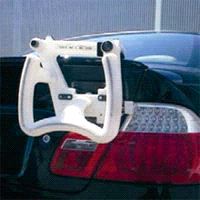Inkjet & Digital Printing
Manufacturing Jigs and Fixtures with FDM

Monday 17. March 2014 - Rapid prototyping has become a standard practice in product development. At the BMW AG plant in Regensburg, Germany, FDM (fused deposition modeling) continues to be an important component in vehicle design prototyping. But moving beyond prototyping, BMW is extending the application of FDM to other areas and functions, including direct digital manufacturing.
The plant’s department of jigs and fixtures uses a Stratasys 3D Production System to build hand-tools for automobile assembly and testing. According to engineer Günter Schmid, “BMW has determined that the FDM process can be an alternative to the conventional metal-cutting manufacturing methods like milling, turning, and boring.” Schmid and fellow engineer, Ulrich
Eidenschink, have shown that financial advantages include cost reductions in engineering documentation, warehousing, and manufacturing.
For hand-held devices used on the assembly line, engineers have discovered that there are even greater advantages that arise from the design freedom that FDM offers. Capitalizing on the elimination of constraints, Schmid and Eidenschink employ FDM to make ergonomically designed assembly aids that perform better than conventionally made tools.
Real Solution
To improve productivity, worker comfort, ease-of-use, and process repeatability, the plant uses FDM to enhance the ergonomics of its hand-held assembly devices. The freedom of design allows engineers to create configurations that improve handling, reduce weight, and improve balance. According to Schmid, “The tool designs we create often cannot be matched by machined or molded parts.” In one example, BMW reduced the weight of a device by 72 percent with a sparse-fill build technique. Replacing the solid core with internal ribs cut 1.3 kg (2.9 lbs) from the device. “This may not seem like much, but when a worker uses the tool hundreds of times in a shift, it makes a big difference,” says Schmid.
Another advantage of direct digital manufacturing is improved functionality. Since the additive process can easily produce organic shapes that sweep and flow, the tool designers can maximize performance while improving handling characteristics. “The layered FDM manufacturing process is well suited for the production of complex bodies that, when using conventional metal-cutting processes, would be very difficult and costly to produce,” says Eidenschink. An example is a tool created for attaching bumper supports, which features a convoluted tube that bends around obstructions and places fixturing magnets exactly where needed.
The jigs and fixtures department has developed a simple flow chart to determine when FDM is a fitting option. The criteria are temperature, chemical exposure, precision, and mechanical load. With Stratasys ABS material, which the engineers find comparable to polyamide (PA 6), many tools for vehicle assembly satisfy the criteria. For those that do, designers can create devices that capitalize on all the advantages of the additive process.
Both Schmid and Eidenschink believe that no enterprise can afford to do without rapid prototyping for product development. Yet, they see so much more possibility. “FDM is taking on increasing importance as an alternative manufacturing method for components made in small numbers,” says Schmid.
